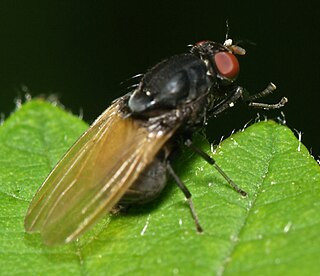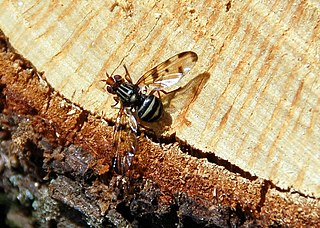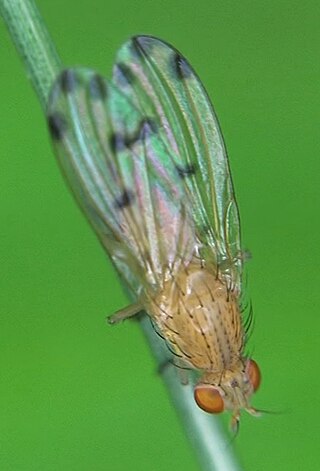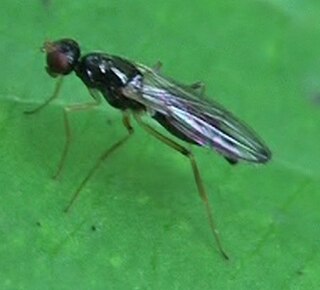
The Drosophilidae are a diverse, cosmopolitan family of flies, which includes species called fruit flies, although they are more accurately referred to as vinegar or pomace flies. Another distantly related family of flies, Tephritidae, are true fruit flies because they are frugivorous, and include apple maggot flies and many pests. The best known species of the Drosophilidae is Drosophila melanogaster, within the genus Drosophila, also called the "fruit fly." Drosophila melanogaster is used extensively for studies concerning genetics, development, physiology, ecology and behaviour. Many fundamental biological mechanisms were discovered first in D. melanogaster. The fruit fly is mostly composed of post-mitotic cells, has a very short lifespan, and shows gradual aging. As in other species, temperature influences the life history of the animal. Several genes have been identified that can be manipulated to extend the lifespan of these insects. Additionally, Drosophila subobscura, also within the genus Drosophila, has been reputed as a model organism for evolutionary-biological studies, along with D. sechellia for the evolution of host specialization on the toxic noni fruit and Scaptomyza flava for the evolution of herbivory and specialist on toxic mustard leaves.

The Ulidiidae or picture-winged flies are a large and diverse cosmopolitan family of flies (Diptera), and as in related families, most species are herbivorous or detritivorous. They are often known as picture-winged flies, along with members of other families in the superfamily Tephritoidea that have patterns of bands or spots on the wings. Some species share with the Tephritidae an unusual elongated posteroapical projection of the anal cell in the wing, but can be differentiated by the smoothly curving subcostal vein. Two species, Tetanops myopaeformis and Euxesta stigmatias, are agricultural pests.

The Lauxaniidae are a family of acalyptrate flies. They generally are small flies with large compound eyes that often are brightly coloured in life, sometimes with characteristic horizontal stripes, such as in Cestrotus species. Many species have variegated patterns on their wings, but in contrast they generally do not have variegated bodies, except for genera such as Cestrotus, whose camouflage mimics lichens or the texture of granitic rocks.

Xylomyidae is a family of flies known commonly as the wood soldier flies. They are xylophagous and are associated with dead or dying wood.

Odiniidae is a small family of flies. There are only 58 described species but there are representatives in all the major biogeographic realms.

The Coelopidae or kelp flies are a family of Acalyptratae flies, they are sometimes also called seaweed flies, though both terms are used for a number of seashore Diptera. Fewer than 40 species occur worldwide. The family is found in temperate areas, with species occurring in the southern Afrotropical, Holarctic, and Australasian regions.

Minettia is a genus of small flies of the family Lauxaniidae. They have almost worldwide distribution, is one of the most species rich genera of the family with more than 120 described species. The Palaearctic is the most diverse with some 56 described species. The genus is divided into 3 subgenera.

Otitinae is the name of a subfamily of flies in the family Ulidiidae. It was formerly the Otitidae. Like the Ulidiinae, most species are herbivorous or saprophagous. Most species share with the Tephritidae an unusual elongated projection of the anal cell in the wing, but can be differentiated by the smoothly curving subcostal vein. Most are dull gray to shiny brown or black flies with vein R1 setulose or, in a few cases, bare.

Platystomatinae is a subfamily of flies (Diptera) in the family Platystomatidae that includes 80 genera, the largest subfamily with at last estimate, c. 900 species globally.

Meiosimyza is a genus of small flies of the family Lauxaniidae.

Elassogaster is a genus of scavenger flies (Diptera) belonging to the family Platystomatidae. They are native to warm regions of Africa, Madagascar, Asia and Australia.

Loxocera is a genus of flies and member of the family Psilidae.
Trigonometopus is a genus of flies in the family Lauxaniidae. There are more than 20 described species in Trigonometopus.
Hecamede is a genus of shore flies.
Phyllomyza is a genus of freeloader flies in the family Milichiidae. There are at least 30 described species in Phyllomyza.

Strongylophthalmyia are a genus of slender, long-legged flies, the majority of which occur in the Oriental and Australasian regions.
Telostylus is a genus of flies in the family Neriidae.













